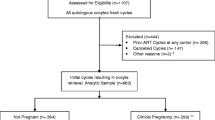Abstract
Purpose: The present study was undertaken in order to analyze possible factors that could be responsible for multiple pregnancies in normoovulatory women undergoing superovulation with gonadotropins and intrauterine artificial insemination.
Methods: We retrospectively analyzed several clinical parameters in patients that achieved gestation with this treatment. Patients were divided into two groups depending on sperm origin (husband and donor sperm). Furthermore, they were subclassified as follows: (a) cycles resulting in single pregnancies (n=366), (b) cycles ending in multiple pregnancies (n=126), and (c) a control group composed of unsuccessful cycles (n=366).
Results: In cycles employing husband's sperm, the age, number of cycles necessary to reach pregnancy, serum estradiol (E2) levels, and number of follicles were significantly (P<0.05) different in multiple pregnancies compared to single or nonpregnant cycles. In donor insemination, women with multiple pregnancies were significantly younger than nonpregnant patients. There was a significant increase in the number of follicles developed (P<0.00001) and serum E2 levels on the day of hCG (P<0.05) in multiple compared to single pregnancies and unsuccessful cycles. The number of motile sperm in the insemination specimen was not different among the established groups. When both types of treatments were grouped, pregnant patients were significantly (P<0.00001) younger than women with failed cycles. In addition, multifetal pregnancies were significantly (P<0.05) more frequent in women <30 years old. E2 production was significantly (P<0.00008) higher in twin and multifetal pregnancies than in single or nonpregnant cycles. Follicular development was also significantly (P<0.00001) higher in twin and multifetal pregnancies compared to failed cycles.
Conclusions: The results suggest that young women (<30 years) who develop more than six follicles with E2 >1000 pg/ml when stimulated with gonadotropins are at higher risk of multiple gestation. These data may be helpful in preventing this undesired complication of assisted reproduction techniques.
Similar content being viewed by others
References
Chaffkin LM, Nulsen JC, Luciano AA, Metzger DA: A comparative analysis of the cycle fecundity rates associated with combined human menopausal gonadotropin (hMG) and intrauterine insemination (IUI) versus either hMG or IUI alone. Fertil Steril 1991;55:252–257
Dodson WC, Haney AF: Controlled ovarian hyperstimulation and intrauterine insemination for treatment of infertility. Fertil Steril 1991;55:457–467
Kerin JFP, Peek J, Warnes MG,et al.: Improved conception rate after intrauterine insemination of washed spermatozoa from men with poor quality semen. Lancet 1984;1:533–534
Shelden R, Kemmann E, Bohrer M, Pasquale S: Multiple gestation is associated with the use of high sperm numbers in the intrauterine insemination specimen in women undergoing gonadotropin stimulation. Fertil Steril 1988;49:607–610
Derom C, Derom R, Vlietinck R, Maes H, Van den Bergue H: Iatrogenic multiple pregnancies in East Flanders. Belgium. Fertil Steril 1993;60:493–496
Gleicher N, Campbell DP, Chan ChL, Karande V, Rao R, Balin M, Pratt D: The desire for multiple births in couples with infertility problems contradicts present practice patterns. Hum Reprod 1995;10:1079–1084
Manzur A, Goldsman MP, Stone SC, Frederick JL, Balmaceda JP, Asch RH: Outcome of triplet pregnancies after assisted reproductive techniques: how frequent are the vanishing embryos? Fertil Steril 1995;63:252–257
Bollen N, Camus M, Tournaye H, Wisanto A, Van Steirteghem AC, Devroey P: Embryo reduction in triplet pregnancies after assisted procreation: A comparative study. Fertil Steril 1993;60:504–509
Maymon R, Herman A,et al.: First trimester embryo reduction: A medical solution to an iatrogenic problem. Hum Reprod 1995;10:668–673
Dodson WC, Hughes CL, Haney AF: Multiple pregnancies conceived with intrauterine insemination during superovulation: An evaluation of clinical characteristics and monitored parameters of conception cycles. Am J Obstet Gynecol 1988;159:382–385
Dickey RP, Olar TT, Taylor SN, Curole DN, Rye PH, Matulich EM: Relationship of follicle number, serum estradiol, and other factors to birth rate and multiparity in human menopausal gonadotropin-induced intrauterine insemination cycles. Fertil Steril 1991;56:89–92
WHO: Laboratory Manual for the Examination of Human Semen and Sperm-Cervical Mucus Interaction, 3rd ed. Cambridge, Cambridge University Press, 1992, pp 43–44
Pellicer A, Ruiz A, Castellví RM,et al.: Is the retrieval of high numbers of oocytes desirable in patients treated with gonadotrophin-releasing hormone analogues (GnRHa) and gonadotropins? Hum Reprod 1989;4:536–540
Author information
Authors and Affiliations
Rights and permissions
About this article
Cite this article
Valbuena, D., Simón, C., Romero, J.L. et al. Factors responsible for multiple pregnancies after ovarian stimulation and intrauterine insemination with gonadotropins. J Assist Reprod Genet 13, 663–668 (1996). https://doi.org/10.1007/BF02069646
Received:
Accepted:
Issue Date:
DOI: https://doi.org/10.1007/BF02069646




